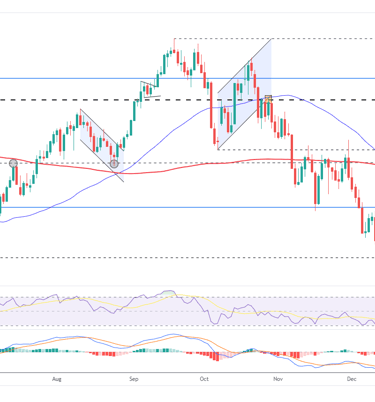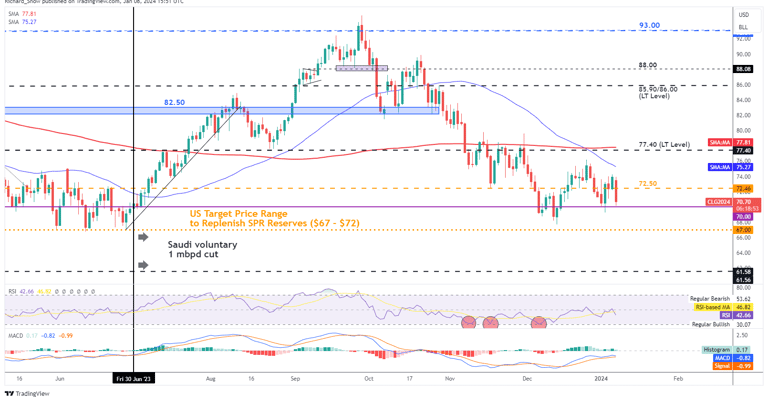WTI, Brent Crude Oil Analysis: Navigating Market Challenges Amid Geopolitical Tensions and Demand Concerns
At the onset of the week, oil prices are retracing previous gains, counteracting the theoretically bullish effects of Houthi attacks leading to rerouting of cargoes in the Red Sea.
NEWS
1/18/20242 min read
WTI, Brent Crude Oil Analysis: Navigating Market Challenges Amid Geopolitical Tensions and Demand Concerns
Introduction:
This analysis delves into the recent developments in WTI and Brent crude oil markets, exploring the impact of geopolitical tensions and demand-related challenges. Despite ongoing geopolitical concerns, both benchmarks are experiencing downward pressure as factors such as Saudi Arabia's signals and seasonally lower demand contribute to bearish sentiment. Chart patterns and key levels provide insights into potential support and resistance areas.
Saudi Arabia's Signal of Challenges Amid Lower Demand:
At the onset of the week, oil prices are retracing previous gains, counteracting the theoretically bullish effects of Houthi attacks leading to rerouting of cargoes in the Red Sea. Despite geopolitical tensions, both Brent and WTI benchmarks have declined around 4%, influenced by various fundamental factors. Saudi Arabia's decision to lower its official selling price for February shipments to Asia suggests weakening demand from China, a significant player in the oil market. Additionally, the seasonally lower demand in Q1 adds to concerns of oversupply in the oil market.
Brent Crude Oil Price Drop and Support Levels:
Brent crude oil prices, after failing to breach the 50-day simple moving average (SMA) last week, experienced a sharp decline at the beginning of the current week. The rejection of the 50 SMA underscores bearish sentiment, with $71.50 emerging as a critical support level. This level, which prevented further selling in May and June 2023, gains significance in the current scenario. The bearish trend, reflected in the longer-term downtrend, aligns with global growth concerns and economic challenges in China. While the Relative Strength Index (RSI) indicates potential for extended selling pressure, the evolving situation in the Middle East remains a factor that could limit further downside.
WTI's Test at $70 with $67 on the Horizon:
The WTI chart mirrors the bearish sentiment observed in Brent, showcasing a drop of up to 4.8% by 17:00 GMT. Immediate support is found at the $70 mark, with $67 looming as a notable level on the horizon. The Biden administration's reconsideration of refilling the Special Petroleum Reserve (SPR) at oil prices between $67 and $72, along with indications of a prolonged process, diminishes expectations of significant buying at these levels. Despite this, $67 holds technical significance, making it an area of interest.
Conclusion:
Navigating the complexities of WTI and Brent crude oil markets in the face of geopolitical tensions and demand challenges requires a careful analysis of key support and resistance levels. While fundamental factors contribute to bearish sentiment, the evolving Middle East situation and technical levels, especially $71.50 and $67, will play crucial roles in determining the trajectory of both benchmarks. Traders and investors must stay vigilant amid the dynamic landscape of the oil market.




Forex Finviz.com
______________
© 2023 Forex Finviz All rights reserved. Terms of Use | Disclaimers | Privacy Policy
Advertiser Disclosure: Forexfinviz.com helps investors across the globe by spending over 1,000 hours each year testing and researching online brokers. How do we make money? Our partners compensate us through paid advertising. While partners may pay to provide offers or be featured, e.g. exclusive offers, they cannot pay to alter our recommendations, advice, ratings, or any other content throughout the site. Furthermore, our content and research teams do not participate in any advertising planning nor are they permitted access to advertising campaign data. Here's how we make money:.
Disclaimer: It is our organization's primary mission to provide reviews, commentary, and analysis that are unbiased and objective. While Forexfinviz.com has some data verified by industry participants, it can vary from time to time. Operating as an online business, this site may be compensated through third party advertisers. Our receipt of such compensation shall not be construed as an endorsement or recommendation by Forexfinviz.com , nor shall it bias our reviews, analysis, and opinions. Please see our General Disclaimers for more information.


